2011年同等学力英语考试真题及详解
- 格式:docx
- 大小:77.62 KB
- 文档页数:25
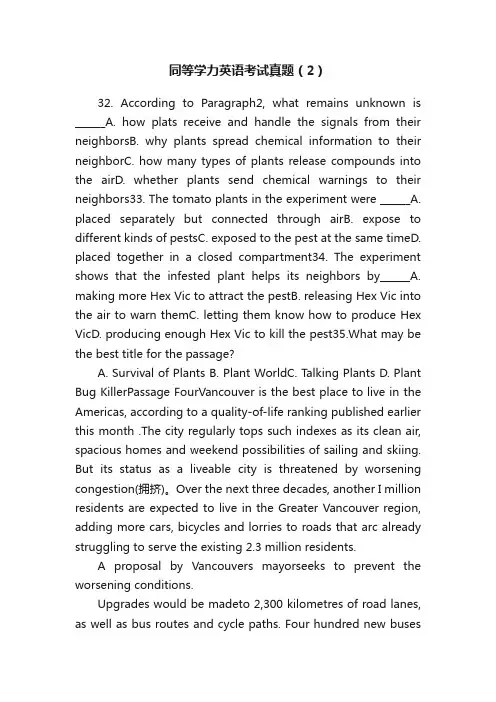
同等学力英语考试真题(2)32. According to Paragraph2, what remains unknown is ______A. how plats receive and handle the signals from their neighborsB. why plants spread chemical information to their neighborC. how many types of plants release compounds into the airD. whether plants send chemical warnings to their neighbors33. The tomato plants in the experiment were ______A. placed separately but connected through airB. expose to different kinds of pestsC. exposed to the pest at the same timeD. placed together in a closed compartment34. The experiment shows that the infested plant helps its neighbors by______A. making more Hex Vic to attract the pestB. releasing Hex Vic into the air to warn themC. letting them know how to produce Hex VicD. producing enough Hex Vic to kill the pest35.What may be the best title for the passage?A. Survival of PlantsB. Plant WorldC. Talking PlantsD. Plant Bug KillerPassage FourVancouver is the best place to live in the Americas, according to a quality-of-life ranking published earlier this month .The city regularly tops such indexes as its clean air, spacious homes and weekend possibilities of sailing and skiing. But its status as a liveable city is threatened by worsening congestion(拥挤)。
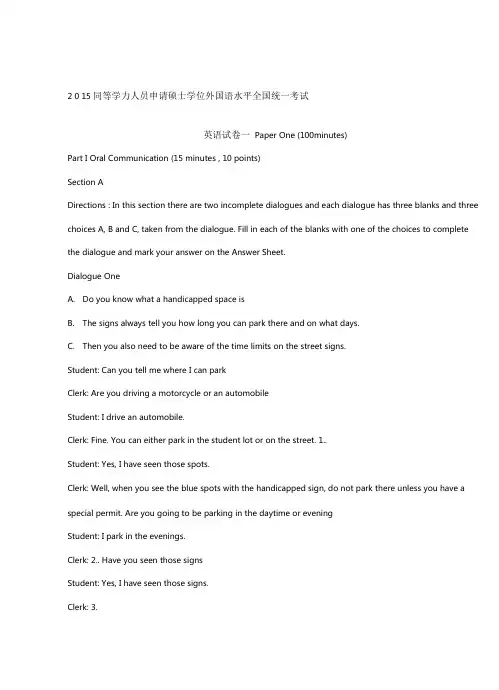
2 0 15同等学力人员申请硕士学位外国语水平全国统一考试英语试卷一Paper One (100minutes)Part I Oral Communication (15 minutes , 10 points)Section ADirections : In this section there are two incomplete dialogues and each dialogue has three blanks and three choices A, B and C, taken from the dialogue. Fill in each of the blanks with one of the choices to complete the dialogue and mark your answer on the Answer Sheet.Dialogue OneA.Do you know what a handicapped space isB.The signs always tell you how long you can park there and on what days.C.Then you also need to be aware of the time limits on the street signs.Student: Can you tell me where I can parkClerk: Are you driving a motorcycle or an automobileStudent: I drive an automobile.Clerk: Fine. You can either park in the student lot or on the street. 1..Student: Yes, I have seen those spots.Clerk: Well, when you see the blue spots with the handicapped sign, do not park there unless you have a special permit. Are you going to be parking in the daytime or eveningStudent: I park in the evenings.Clerk: 2.. Have you seen those signsStudent: Yes, I have seen those signs.Clerk: 3.Dialogue TwoA.The hours and limitations are printed on the card and this handout.B.May I have your driver ' s license, pleaseC.Are you familiar with our rules and finesStudent: Excuse me. I am interested in getting a library card.Librarian: Sure, let me give you an application. You can fill it out right here at the counter.Student: Thank you. I ' II do it right now.Librarian: Let me take a look at this for you. 4..Student: Here it is.Librarian: You seem to have filled the form out all right. 5..Student: Yes. I know what to do.Librarian: 6.Student: OK. I see.Librarian: Thank you for joining the library. We look forward to serving you.Section BDirections : In this section there is one incomplete which has four blanks and four choices A, B, C and D, taken from the interview. Fill in each of the blanks with one of the choices to complete the interview and mark your answer on the Answer Sheet.A.And fooled the boys for a while.B. And I don ' t think the boys have minded.C. Well, it ' s because my British publisheD. All this time I thought you were 'J.K Winfrey: So, this is the first time we ' ve met.Rowling: Yes, it is.Winfrey: And my producers tell me that your real name is J.O. 7..15. Security guards dispersed the crowd that had gathered around the Capitol.appeal to boys ' , but they didn ' t want the boys to know a woman had written it. So they said t6. To start the program, insert the disk and follow the instructions.name. So I took my favorite grandmot her' s name, Kathleen.17. The patient ' s conditiodeteriorated since last night.Rowling: Yeah, but not for too long, because I started getting my picture in the press and no one 18. Icouldn ' t afford to fly home, and a train ticket wkewise beyond my means.19. Despite years of searching, scientists have detected no signs of life beyond our own solarRowling: NO ——it hasn ' t held me back, has itDirections: In this part there are ten sentences, each with one word or phrase underlined. Choose20. I prefer chicken to fish because I am worried about accidentally swallowing a small bone.12. Earth has an atmosphere, which protects the surface from harmful rays. each with four suggestedanswers A, B, C and D. Choose the best answer and mark your answerA. mineralsB. substancesC. gasesD. beams13. The manager gave one of the salesgirls an accusing look for her hostile attitude towardPassage OneSometimes a race is not enough. Sometimes a runner just wants to go further. That ' w hat14. Since it is late to change my mind now, I am resolved to carry out the plan.Rowling: (laughing) Yeah. A. revise B. implement C. review D. improveme ' could we use your initialsand I said ' fine ' . I only have one initial. I donA. take odhave a middleB. turn overC. track downD. put inWinfrey: 9.A. improvedB. returnedC. worsenedD.changedcould pretend I was a man anymore. A. alsoB. nonethelessC. furthermoreD. otherwisePart II Vocabulary(10 points)A. withinB. besidesC. outsideD. exceptthe one from the four choices marked A, B, C and D that best keeps the meaning of the sentence. A. intentionallyB. unexpectedlyC. anxiouslyD. hurriedlyMark your answer on the Answer Sheet. Part III Reading Comprehension (25 points) 11. There are several different options for getting Internet access. Section AA. choicesB. definitionsC. channelsD. reasonsDirections : In this section, there are four passages followed by questions or unfinished statements, Winfrey: J.K is Rowling: 8..When the first book came out, they thought ' thisis a book that willA. arrestedB. stoppedC. scatteredD. watchedWinfrey: 10.system. on the Answer Sheet. customers. A. unfriendlyB. optimisticC. impatientD. positivehappened to Dennis Martin and Brooke Curran.Martin, 68, a retired detective form New York City, took up running after his first wife died.Curran, 46, a philanthropist(慈善家)from Alexandria, started running to get out of the house and collect her thoughts. Both she and Martin got good at running but felt the desire to do more.more I trained, the better I got,accomplishment.”Eventually , they worked up to running marathons(马拉松)(and longer races) in other countries, on other countries. Now both have achieved a notable -and increasingly less rate- milestone; running the 26.2-mile race on all seven continents.They are part of a phenomenon that has grown out of the running culture in the past two decades, at the intersection of athleticism and leisure:George Island. Off the tip of the Antarctic Peninsula; 160 runners got to the starting line of a dirt-and ice-trail route via a Russian icebreaker through the Drake Passage.21.At the beginningThartin took up running just to.B.win a running raceC.join in a philanthropic activityD. get away fromhis sadness22.Martin and Curran are mentioned as good examples of.A.winners in the 26.2-mile race on all seven continentsB.people who enjoy long running as a lifestyle activityC.running racers satisfied with their own performancetravel to exotic places. There trips, as expensive as they are physically challenging, are a growing and competitive market in the travel industry.Tnthe beginning, running was enough, "said Steen Albrechtsen, a press manager. The classic marathon was the ultimate goal, then came the super marathons, like London and New York. But when 90,000 people a year can take that challenge, it is no longer exciting and adventurous. Hence, the search for new adventures began.”"Noone could ever have imagined that running would become the lifestyle activity that it is today, said Thom Gilligan, founder and president of Boston-based Marathon Tours and Travel.Gilligan, who has been in business since 1979, is partly responsible for the seven-continent phenomenon.It started with a casual talk to an interviewer about his company offering trips to every continent except Antarctica. And then in 1995, Marathon fours hosted its first Antarctica Marathon on King 23. A new trend in the travel industry is the development of.A.challenging runcationsB. professional racesC. Antarctica travel marketD. expensive tours24.The classic marathon no longer satisfies some people because.A.it does not provide enough challengeB. it may be tough and dangerousC. it involves too fierce a competitionD. it has attracted too many people25.The first Antarctica Marathon on King George Island indicates that.A.international cooperation is a must to such an eventB.runcations are expensive and physically challengingC.Marathon Tours is a leader of the travel industryD.adventurous running has become increasingly popularCurran said, but I would cross the finish line with no sens e eifrequirements of his jobruncations, which combine distance . raldnpeg)wehwho live an active 肝e after retirementPassage TwoBefore the 1970s, college students were treated as children. So many colleges ran in loco parentis about safety issues and grades. They want to make sure their financial investment is not being system. Tn loco parentis " is a Latmetanmg "in thplace of a parent. " It describes whenwasted.someone else accepts responsibility to act in the interests of a child.This idea developed long ago in British common law to define the responsibility of teachers toward their students. For years, American courts upheld in loco parentis in cases such as Gott versus Berea College in 1913.Gott owned a restaurant off campus. Berea threatened to expel students who ate at places not owned by the school. The Kentucky high court decided that in loco parentis justified that rule.In loco parentis meant that male and female college students usually had to live in separate buildings. Women had to be back at their dorms by ten or eleven on school nights.But in the 1960s, students began to protest rules and restrictions like these. At the same time, courts began to support students who were being punished for political and social dissent.In 1960, Alabama State College expelled six students who took part in a civil rights demonstration. They sued the school and won. After that it became harder and harder to defend in loco parentis.At that time, students were not considered adults until 21. Then, in 1971, the 24th amendment to theConstitution set the voting age at eighteen. So in loco parentis no longer really applied.Slowly, colleges began to treat students not as children, but as adults. Students came to be seen as consumers of educational services.Gary Dickstein, an assistant vice president at Wright State University in Dayton, Ohio, says in loco parentis is not really gone. It just looks different. Today involved in students ' livelihey are known as " helicopterparents.26. Before the 1970s, many colleges ran in loco parentis system because.A. they could take the place of the students ' parentsB. parents asked them to do it for the interests of their childrenC. this was a tradition established by British collegesD. college students were regarded as too young to be treated as adults 27. Who won the case of Gott versus Berea College in 1913 A. Berea College. B. Gott.C. It was a win-win case.D. The students.28. The word "dissent ” (Para.5) probably means "”. A. extreme behaviors B. violation of laws C. strong disagreementD. Wrong doings29. In 1960, the court ruled that Alabama State College A. had no right to expel the studentsB. was justified to have expelled the studentsC. shouldn ' t interfere with students' Da syiofdd support civil rights demonstrations 30. According to Gary Dickstein, today' s " helicopter parentsA. don ' t set their hearts at rest with college administratorsB. keep a watchful eye on their children ' s life and studyC. care less about their children' s education than befores educationover their children. Gary Dickstein says these parents are likely to question decisions, especiallys parents, he says, are often heavhyve different opinions on their children Theways seem to hover Passage ThreeWe tend to think of plants as the furniture of the natural worl d. They don ' t move they don ' t makants have to build their own weapon to fight off bugs and diseases. How do they know when tosounds, they don ' t seem to respond to anythin least not very quickly. But as is often the case, our human view of the world misses quite a lot. Plants talk to each other all the time. And the language is chemical. Over the years scientists have reported that different types of plants, from trees to tomatoes, release compounds into the air to help neighboring plants. These chemical warnings all have the same purpose to spread information about one plant ' disease so other plants can defend themselves. But exactly how plants receive and act on many of these signals is still mysterious.In this wee k' s Proceedings of the National Academy of Sciences, researchers in Japan offer some explanations. They have identified one chemical message and traced it all the way from release to action. The scientists looked at tomato plants infested(侵害)by common pest, the cutworm caterpillar(毛虫).To start out, they grew plants in two plastic compartments connected by a tube. One plant was infested and placed upwind and the others were uninfested and placed downwind. The downwind plants were later exposed to the cutworm caterpillar. The results showed that plants that had previously been near sick neighbors were able to defend themselves better against the caterpillar.The researchers also studied leaves from exposed and unexposed plants. They found one compound showed up more often in the exposed plants. The substance is called Hex Vic. When the scientists fed Hex Vic to cutworms, it knocked down their survival rate by 17%. The scientists identified the source of Hex Vic, and sprayed it lightly over healthy plants. Those plants were then able to start producing the caterpillar-killing Hex Vic. Researchers confirmed that uninfested play defense They are warned first by their friendly plant neighbors.It is a complex tale, and it may be happening in more plant species than tomatoes. It may also be happening with more chemical signals that are still unknown to us. For now though, we know that plants not only communicate, they look out for one another. 31.What does the author try to emphasize Paragraph 1.A.How plants communicate is still a mystery.B.Enough attention has been paid to plant talk.C.Plants are the furniture of the natural world.D.Plants can communicate with each other.32.According to Paragraph 2, what remains unknown isA.how plants receive and handle the signals from their neighborsB.why plants spread chemical information to their neighborC.how many types of plants release compounds into the airD.whether plants send chemical warnings to their neighbors33.The tomato plants in the experiment wereA.placed separately but connected through airB.expose to different kinds of pestsC.exposed to the pest at the same timeD.placed together in a closed compartment34.The experiment shows that the infested plant helps its neighbors byA.making more Hex Vic to attract the pestB.releasing Hex Vic into the air to warn themC.letting them know how to produce Hex VicD.producing enough Hex Vic to kill the pest35.What may be the best title for the passageA. Survival of PlantsB. Plant WorldC. Talking PlantsD. Plant Bug KillerPassage FourVancouver is the best place to live in the Americas, according to a quality-of-life ranking published earlier this month .The city regularly tops such indexes as its clean air, spacious homes and weekend possibilities of sailing and skiing. But its status as a livable city is threatened by worsening congestion(拥挤).Over the next three decades, another 1 million residents are expected to live in the Greater Vancouver region, adding more cars, bicycles and lorries to roads that arc already struggling to serve the existing 2.3 million residents.A proposal by Vancouver ' s to prevent the worsening conditions. Upgrades would be made to 2,300 kilometres of road lanes, as well as bus routes and cycle paths. Four hundred new buses would join the fleet of 1,830. There would be more trains and more "sei)us" ferry crossings between Vancouver and its wealthy northern suburbs. To get all that, residents must vote to accept an increase in sales tax, from 7% to 7.5%. Polls suggest they will vote no. Everyone agrees that a more efficient transport system is needed. Confined by mountains to the north, the United States to the south and the Pacific Ocean to the west, Vancouver has spread in the only direction where there is still land, into the Fraser Valley, which just a few decades ago was mostly farmland. The road is often overcrowded. Yet commuters ' suspicion of local bureaucrats may exceed their dislike of congestion. TransLink, which runs public transport in the region, is unloved by taxpayers. Passengersblame it when Skytrain,the light-rail system, comes to a standstill because of mechanical or electrical faults, as happened twice in one week last summer, leaving commuters stuck in carriages with nothing to do but expressing their anger on Twitter. That sort of thing has made voters less willing to pay the C$7.5 billion in capital spending that the ten-year trafficupgrade would involve.Despite the complaints, Vancouver ' s transport system is a deceirttage^ted one on which to build, reckons Todd Litman, a transport consultant who has worked for TransLink. "These upgrades are all-important if Vancouver wants to maintain its reputation for being a destination others want to go to. " He says.36.The biggest problem threatening Vancouver as a livable city is.A.increasing congestionB. climate changeC. shortage of landD. lack of money37.The upgrade proposal by Vancouver ' mayor may be turned down by residents becauseA.they do not want more people to move inB.they are reluctant to move to new placesC.upgrades would take away their living spaceD.upgrades would add to their financial burdens38.The only direction for Vancouver to further expand is towards.A. the eastB. the westC. the southD. the north39.TransLink is mentioned (Para.4) as an example of.A.world famous transport companiesB.local residents ' complaints about the bureaucratsC.local effort to improve public transportD.worsening traffic congestion40.According to Todd Litman, the upgrade proposal.A.will solve the traffic problemB.will benefit local economyC.satisfies the transport companyD.deserves public supportSection BDirections: In this section, you are required to read one quoted blog and the comments on it. The blog and comments are followed by questions or unfinished statements, each with four suggested answers A, B, C and D. Choose the best answer and mark your answer on the Answer Sheet.Towards the end of the 1990s, more than a decade and a half Diet Coke was first introduced, sale of Coca Cola ' s -tiling low caloric drink appeared to slow down.However, in the decade that followed, diet sodas grew by more than 30 percent. In 2009, sales pushed above $8.5 billion for the first time. But America ' toirst for Diet Coke is running dry again-and this time it could be for good. The diet soda slowdown isn ' t merely an American■折tn0 s also happening worldwide. But the future of diet colas is particularly cloudy in the United States.Low calorie sodas are fighting a hard battle against not one but two trends among American consumers. The first is that overall soda consumption has been on the decline since before 2000.Diet sodas, though they might come sugar- and calorie-free, are still sodas, something Americans are proving less and less interested in drinking.The second, and perhaps more significant trend, is a growing mistrust of artificial sweeteners(甜味齐ij). a Consumers ' attitudes towards sweeteners have really chKai(d|itbward Telford, anindustry analyst. "There ' s a very negative perception about artificial sweeteners. The industry is still trying to get its head around this. ”Comment 1Add me to the number of people addicted to diet colas who quit drinking soda altogether. I honestly think soda is addictive and I ' m happy not to be drinking it anymore.Comment 2Perhaps the slowdown has something more to do with the skyrocketing cost of soft drinks. Comment 3I LOVE diet drinks! Am I unhealthy Who knows I guarantee I have a better physique than most 43-year-old men. Comment 4This is a silly and shallow piece. The reason for the fall off is simply the explosion in consumption of bottled waters and energy drinks.CommentsAs people learn more about health and wellness they will consume less sugar, less soda, less artificial sweeteners.41.What do we know about diet soda saleA.It began to undergo a gradual drop starting from 2000.B.It was on the decline since the 1990s but is on the rise now.C.It reached its peak in the 2000s but began to drop since then.D.It has been decreasing since the 1990s.42.What does the author think of the prospects of diet soda saleA.It will continue to drop.B.It will get better soon.C.It is hard to say for sure.D.It may have ups and downs.43.Which comment gives a personal reason for quitting diet colasA. Comments.B. Comment4.C. Comments.D. Commentl.44.Which comment supports the author ' erf piswtA. Comment2.B. Comments.C. Comment4.D. Comments.45.Which comments disagree with the author on the author on the cause of soda sale slowdownA. Comments and Comments.B. Comment2 and Comment4.C. Commentl and Comment4.D. Comment2 and Comments.Part IV Cloze (10 points)Directions: In this part, there is a passage with ten blanks. For each blank there are four choices marked, A, B, C, and D. Choose the best answer for each blank and mark your answer on the Answer Sheet.When asked about the impact of disturbing news on children, one mother said: -year-old daughter doesn ' t like watching the news. She has 46 about what she has seen. One time,she watched a report about a person who killed a family member with a knife. That night she dreamed that she too was being kille d. w Another interviewee said: My six-year-old niece saw reports of tornadoes(龙卷风)from elsewhere in the country. For weeks 47, she was terrified. She 48 call me on the phone, convinced that a tornado was coming her way andthat she was going to die. ”Do you think disturbing news reports can frighten children In one survey, nearly 40 percent of parents said that their children had been 49 by something they saw in the news and that,50, the children had feared that a similar event would happen to them or their loved ones. Why One factor is that children often 51 the news differently from adults. For example,small children may believe that a 52 that is broadcast repeatedly is really happeningrepeatedly.A second factor is that daily reports of disturbing events can distort a child ' s 53 of the world. True, we live in a criticaltimes hard to 54 .” But repeated exposure to disturbingnews reports can cause children to develop lasting fears. " Children who watch a lot of TV news55 to overestimate the occurrence of crime and may perceive the world to be a moredangerous place than it actually is, " observes the Kaiser F甘airily Founda46. A. thoughts B. nightmares C. ideas D. pictures47. A. afterward B. ago C. before D. later48. A. should B. might C. could D. would49. A. bored B. angered C. upset D. disappointed50. A. in no time B. by all means C. all the more D. as a result“ M011.1A. tell B. interpret C. narrate D. treat52. A. tragedy B. comedy C. play D. drama53. A. imagination B. view C. sight D. look54. A. give up B. stick to C. deal with D. set down55. A. prefer B. turn C. come D. tendPart V Text Completion (20 points)Directions : In this part there are three incomplete texts with 20 questions (Ranging from 56 to75). Above each text there are three or four phrases to be completed. First, use the choices provided in the box to completethe phrases. Second, use the completed phrases to fill in the blanks of the text. Mark your answer on the Answer Sheet.Text One A. angrier B.getting C.actionA.which makes you 56B.like 57 any compensationC.to take any 58Picture this situation: you have bought a faulty item from a shop and you take it back to complain. You go directly to the shop assistant and tell them your problem. They say they cannot help you, 59 to the point perhaps where you start insulting the poor shop assistant. This will do youno favours, 60, or even your money back. If you go directly to the first person you see, you may be wasting your time as they may be powerless 61. So the important lesson to be learnt is to make sure firstly that you are speaking to the relevant person, the one who has the authority to make decisions.Text Two A. the smaller B. as much as C. up to a year D. more likely Phrases:A.20% 62 to feel happyB.63 the physical distance between friendsC.but not 64 happinesssted for 65The new study found that friends of happy people had a greater chance of being happy themselves. And 66 ____________________________________ , the larger the effect they had on each other's happiness. For example, a person was 67 _____________ if a friend living within one and a half kilometers was alsohappy. Having a happy neighbor who lived next door increased an individualhappy by 34%. The effects of friends' happiness 68. The researcher found that happiness really is contagious (传染的).Sadness also spread among friends, 69. Phrases:A.remember past impulse purchases that you 70B.you may 71 _________ purchase on impulseC.keep 72 under controlIn addition to the external pressure we face from marketing, our own feelings and habits can contribute to excessive spending. Here are some suggestions to help you 73 ________________________________ . First, resist your impulse buying. Do you enjoy the excitement of shopping and finding a bargain If so, 74. To resist, slow down and think realistically about the long-term consequences of buying, owning, and maintaining what you are planning to buy. Stop and 75. Give yourself a “cool down " period before making your final decision.Paper Two(50minutes)Part VI Translation (10 points)Directions: Translate the following passage into Chinese. Write your answer on the Answer Sheet.Should work be placed among the cases of happiness or be regarded as a burden Much work is exceedingly tiresome, and an excess of work causes stress and even disease. I think, however, that, provided work is not excessive in amount, even boring work is less harmful than idleness. We sometimes feel a little relief from work; at other times work gives us delight. These feeling arise according to the type of work we are doing and our ability to do that work. Work fills many hours of the day and removes the need to decide what one should do.Phrases: Text Three A. later regretted B. spending C. tend tos chaffcsrtoVbeingiting (15 points)Directions: Write a composition in no less than 150 words on the topic: How can we contribute to the environmental protection You should write according to the outline given below. Write your composition on the Answer Sheet.环境保护已成为我们的共同的责任。
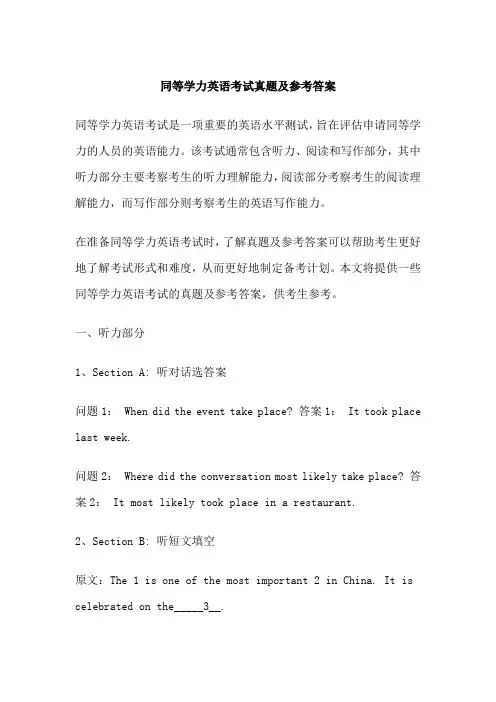
同等学力英语考试真题及参考答案同等学力英语考试是一项重要的英语水平测试,旨在评估申请同等学力的人员的英语能力。
该考试通常包含听力、阅读和写作部分,其中听力部分主要考察考生的听力理解能力,阅读部分考察考生的阅读理解能力,而写作部分则考察考生的英语写作能力。
在准备同等学力英语考试时,了解真题及参考答案可以帮助考生更好地了解考试形式和难度,从而更好地制定备考计划。
本文将提供一些同等学力英语考试的真题及参考答案,供考生参考。
一、听力部分1、Section A: 听对话选答案问题1: When did the event take place? 答案1: It took place last week.问题2: Where did the conversation most likely take place? 答案2: It most likely took place in a restaurant.2、Section B: 听短文填空原文:The 1 is one of the most important 2 in China. It is celebrated on the_____3__.答案:1、Spring Festival2、holidays3、lunar calendar's first day二、阅读部分1、Passage 1: 一篇关于互联网的短文,其中介绍了互联网的发展历史、现状和未来发展趋势。
问题1: What is the main topic of this passage? 答案1: The main topic of this passage is the Internet.问题2: What is the author's attitude towards the future development of the Internet? 答案2: The author is optimistic about the future development of the Internet.2、Passage 2: 一篇关于环保的短文,其中介绍了环保的重要性、当前的环境问题以及我们可以采取的行动。
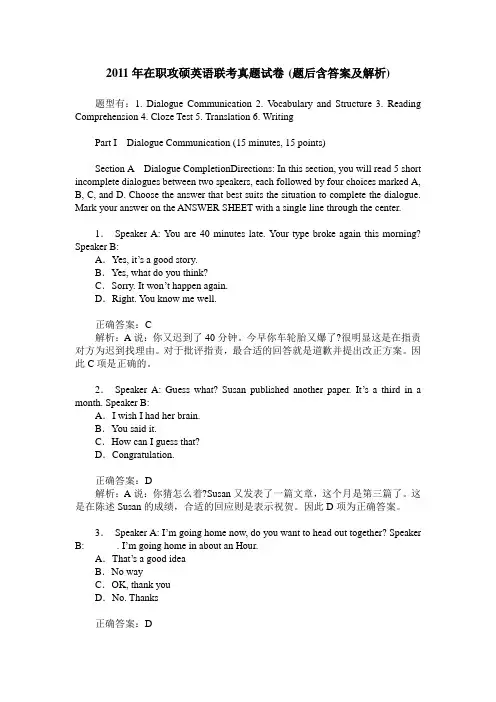
2011年在职攻硕英语联考真题试卷(题后含答案及解析)题型有:1. Dialogue Communication 2. V ocabulary and Structure 3. Reading Comprehension 4. Cloze Test 5. Translation 6. WritingPart I Dialogue Communication (15 minutes, 15 points)Section A Dialogue CompletionDirections: In this section, you will read 5 short incomplete dialogues between two speakers, each followed by four choices marked A, B, C, and D. Choose the answer that best suits the situation to complete the dialogue. Mark your answer on the ANSWER SHEET with a single line through the center.1.Speaker A: You are 40 minutes late. Your type broke again this morning? Speaker B: ______A.Yes, it’s a good story.B.Yes, what do you think?C.Sorry. It won’t happen again.D.Right. You know me well.正确答案:C解析:A说:你又迟到了40分钟。
今早你车轮胎又爆了?很明显这是在指责对方为迟到找理由。
对于批评指责,最合适的回答就是道歉并提出改正方案。
因此C项是正确的。
2.Speaker A: Guess what? Susan published another paper. It’s a third in a month. Speaker B: ______A.I wish I had her brain.B.You said it.C.How can I guess that?D.Congratulation.正确答案:D解析:A说:你猜怎么着?Susan又发表了一篇文章,这个月是第三篇了。
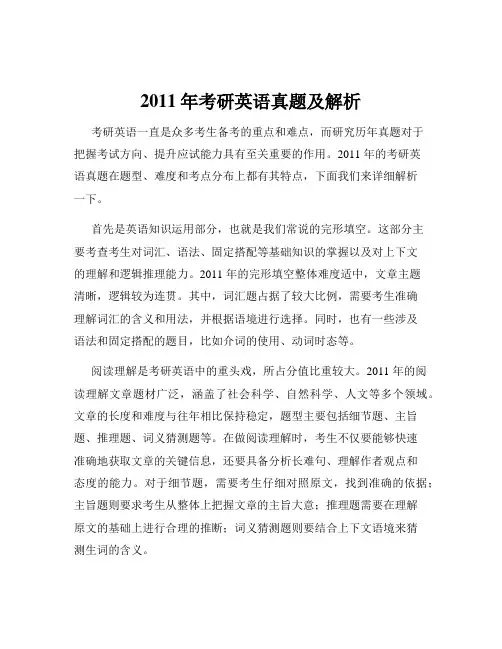
2011年考研英语真题及解析考研英语一直是众多考生备考的重点和难点,而研究历年真题对于把握考试方向、提升应试能力具有至关重要的作用。
2011 年的考研英语真题在题型、难度和考点分布上都有其特点,下面我们来详细解析一下。
首先是英语知识运用部分,也就是我们常说的完形填空。
这部分主要考查考生对词汇、语法、固定搭配等基础知识的掌握以及对上下文的理解和逻辑推理能力。
2011 年的完形填空整体难度适中,文章主题清晰,逻辑较为连贯。
其中,词汇题占据了较大比例,需要考生准确理解词汇的含义和用法,并根据语境进行选择。
同时,也有一些涉及语法和固定搭配的题目,比如介词的使用、动词时态等。
阅读理解是考研英语中的重头戏,所占分值比重较大。
2011 年的阅读理解文章题材广泛,涵盖了社会科学、自然科学、人文等多个领域。
文章的长度和难度与往年相比保持稳定,题型主要包括细节题、主旨题、推理题、词义猜测题等。
在做阅读理解时,考生不仅要能够快速准确地获取文章的关键信息,还要具备分析长难句、理解作者观点和态度的能力。
对于细节题,需要考生仔细对照原文,找到准确的依据;主旨题则要求考生从整体上把握文章的主旨大意;推理题需要在理解原文的基础上进行合理的推断;词义猜测题则要结合上下文语境来猜测生词的含义。
新题型部分,2011 年考查的是排序题。
这种题型要求考生根据文章的逻辑和结构,将打乱顺序的段落重新排列。
这对考生的语篇分析能力和逻辑推理能力提出了较高的要求。
在做这类题目时,首先要快速浏览各个段落,把握其大致内容和主题,然后根据段落之间的衔接词、指代词、逻辑关系等线索进行排序。
翻译部分,2011 年的翻译题目主要考查了考生对长难句的理解和翻译能力。
句子结构较为复杂,包含了各种从句、短语和特殊句式。
在翻译时,需要考生准确分析句子结构,理清各部分之间的关系,然后用通顺、准确的汉语表达出来。
同时,要注意翻译的忠实性和流畅性,避免生硬的直译。
写作部分包括小作文和大作文。
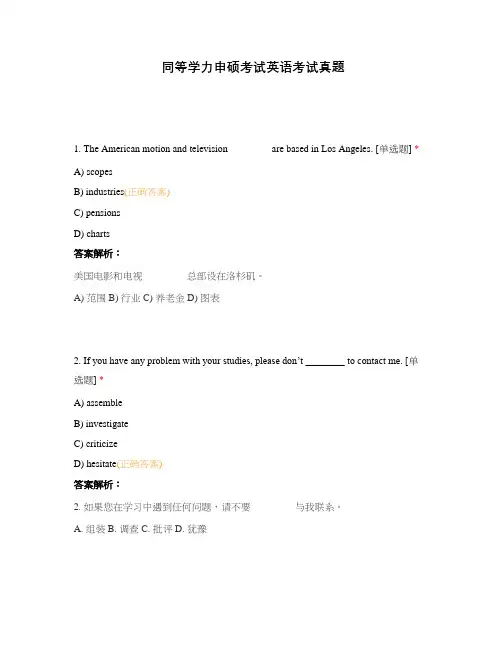
同等学力申硕考试英语考试真题1. The American motion and television ________ are based in Los Angeles. [单选题] *A) scopesB) industries(正确答案)C) pensionsD) charts答案解析:美国电影和电视 ________ 总部设在洛杉矶。
A) 范围 B) 行业 C) 养老金 D) 图表2. If you have any problem with your studies, please don’t ________ to contact me. [单选题] *A) assembleB) investigateC) criticizeD) hesitate(正确答案)答案解析:2. 如果您在学习中遇到任何问题,请不要 ________ 与我联系。
A. 组装B. 调查C. 批评D. 犹豫3. You may even have entered the bookshop just to find ________ from a sudden shower. [单选题] *A) shelter(正确答案)B) shadeC) scheduleD) suspense答案解析:您甚至可能为了躲避一场突如其来的阵雨而走进书店,________。
A. 庇护B. 遮阳C. 时间表D. 悬念4. Life is always ________ new things to the child — things that have lost their interests for older people. [单选题] *A) transplantingB) realizingC) presenting(正确答案)D) acknowledging答案解析:4. 生活对孩子来说总是 ________ 新的东西--对老年人来说已经失去兴趣的东西。
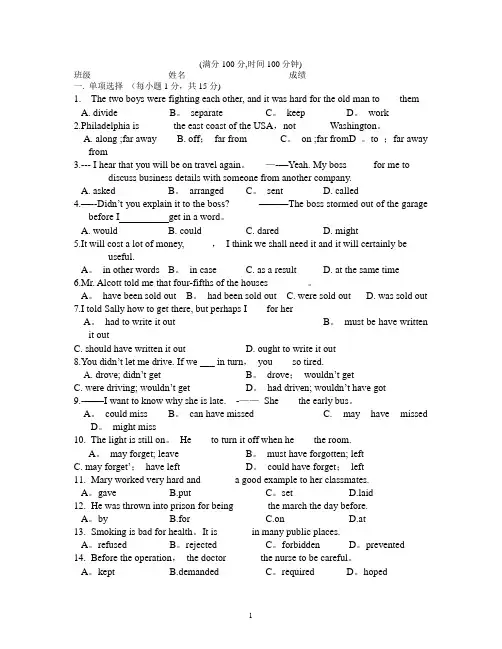
(满分100分,时间100分钟)班级__________ 姓名___________ 成绩_____________一. 单项选择(每小题1分,共15分)1.The two boys were fighting each other, and it was hard for the old man to ___ themA. divide B。
separate C。
keep D。
work2.Philadelphia is ______ the east coast of the USA,not ______ Washington。
A. along ;far awayB. off;far from C。
on ;far fromD 。
to ;far awayfrom3.--- I hear that you will be on travel again。
—-—Yeah. My boss _____for me todiscuss business details with someone from another company.A. asked B。
arranged C。
sent D. called4.—--Didn’t you explain it to the boss?———The boss stormed out of the garagebefore I get in a word。
A. wouldB. couldC. daredD. might5.It will cost a lot of money, _____,I think we shall need it and it will certainly beuseful.A。
in other words B。
in case C. as a result D. at the same time6.Mr. Alcott told me that four-fifths of the houses________。
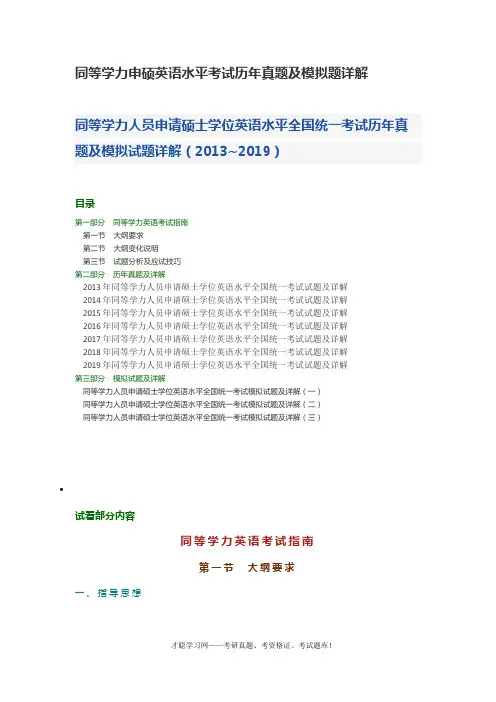
同等学力申硕英语水平考试历年真题及模拟题详解同等学力人员申请硕士学位英语水平全国统一考试历年真题及模拟试题详解(2013~2019)目录第一部分同等学力英语考试指南第一节大纲要求第二节大纲变化说明第三节试题分析及应试技巧第二部分历年真题及详解2013年同等学力人员申请硕士学位英语水平全国统一考试试题及详解2014年同等学力人员申请硕士学位英语水平全国统一考试试题及详解2015年同等学力人员申请硕士学位英语水平全国统一考试试题及详解2016年同等学力人员申请硕士学位英语水平全国统一考试试题及详解2017年同等学力人员申请硕士学位英语水平全国统一考试试题及详解2018年同等学力人员申请硕士学位英语水平全国统一考试试题及详解2019年同等学力人员申请硕士学位英语水平全国统一考试试题及详解第三部分模拟试题及详解同等学力人员申请硕士学位英语水平全国统一考试模拟试题及详解(一)同等学力人员申请硕士学位英语水平全国统一考试模拟试题及详解(二)同等学力人员申请硕士学位英语水平全国统一考试模拟试题及详解(三)•试看部分内容同等学力英语考试指南第一节大纲要求一、指导思想为了客观地测试以同等学力申请硕士学位人员(以下简称同等学力人员)的英语水平,保证学位授予的质量,根据国务院学位委员会办公室关于修订《同等学力人员申请硕士学位外国语水平全国统一考试大纲》的要求以及相关会议的精神,在总结近几年来同等学力人员英语水平统一考试经验的基础上,结合同等学力人员学习英语的特点,开展了第五次修订工作并形成新的考试大纲(第六版)。
本考试大纲要求通过教学使学生具有较好的用英语获取信息的能力和一定的用英语传递信息的能力。
这就要求考生具有较强的阅读理解能力,一定的口语交际能力和语篇信息处理能力,同时也必须具有一定的英译汉能力和写作能力。
本考试旨在测试考生是否达到大纲所规定的各项要求和具有大纲所规定的各项语言运用能力。
二、评价目标本考试重点考查考生的英语口语交际、阅读、语篇完形处理、英译汉和写作等技能(由于技术上的原因,本考试暂时取消听力测试,口语交际技能的测试采用书面形式进行。
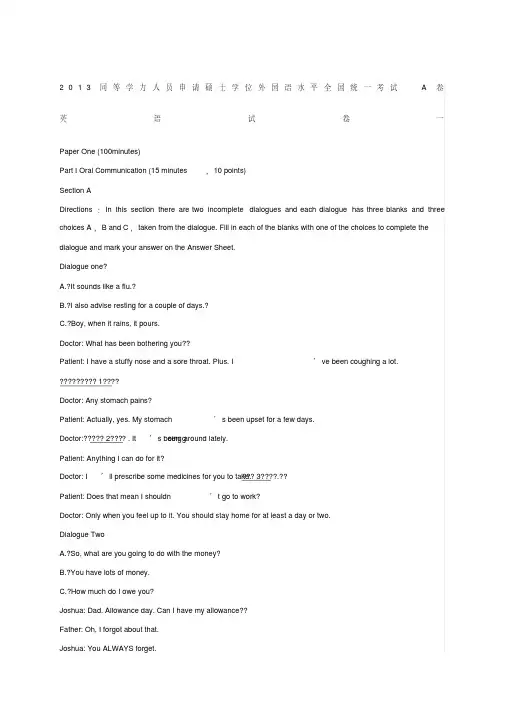
2013同等学力人员申请硕士学位外国语水平全国统一考试A卷英语试卷一Paper One (100minutes)Part I Oral Communication (15 minutes,10 points)Section ADirections:In this section there are two incomplete dialogues and each dialogue has three blanks and three choices A,B and C,taken from the dialogue. Fill in each of the blanks with one of the choices to complete the dialogue and mark your answer on the Answer Sheet.Dialogue one?A.?It sounds like a flu.?B.?I also advise resting for a couple of days.?C.?Boy, when it rains, it pours.Doctor: What has been bothering you??Patient: I have a stuffy nose and a sore throat. Plus, I’ve been coughing a lot. ????????? 1????Doctor: Any stomach pains?Patient: Actually, yes. My stomach’s been upset for a few days.oing around lately.Doctor:????? 2???? . It’s been gPatient: Anything I can do for it?Doctor: I’ll prescribe some medicines for you to take.??? 3????.??Patient: Does that mean I shouldn’t go to work?Doctor: Only when you feel up to it. You should stay home for at least a day or two.Dialogue TwoA.?So, what are you going to do with the money?B.?You have lots of money.C.?How much do I owe you?Joshua: Dad. Allowance day. Can I have my allowance??Father: Oh, I forgot about that.Joshua: You ALWAYS forget.Father: I guess I do.????4???????Joshua: Just $13.Father: Well, I’ m not sure if I have that much.Joshua: Go to bank.??? 5????????????????????????Father: Lots of money, uh? Uh, well, I think the bank is closed.Joshua: Then, what about your secret money jar under your bed?Father: Oh, I guess I could do that.???6????????????Joshua: I ’m going to put some in savings, give some to the poor people, and use the rest to buy books.Father: Well, that sounds greats great, Joshua.Section BDirections:In this section there is one incomplete interview which has four blanks and four choices A,B,C andD taken from the interview. Fill in each of the blanks with one of the choices to complete the interview and markyour answer on the Answer Sheet.A.?Nationalities stay in their own areas,?B.?People don’t queue like they do here in England.C.?What I liked best was that I could work and still lead a normal life.D.?Some supermarkets are open twenty-four hours a day.Interviewer: How long did you stay in the States?Interviewee: I was there for two years, in New York, and I enjoyed it tremendously.?????????????? 7???? I mean, the shops are open till 10:00 .?Interviewer: All shops?Interviewee: yes, everything. Food shops, chemists, and department stores.??????8????. And on public holidays, only the banks are shut.Interviewer: I see, erm … Do you think New York is as multinational as London?Interviewee: Oh, that’s for sure. But it’s not as mixed.?? 9????? like there’s Russian section, the German section and China town. But I think the major difference between these two cities was the height of the place.Everything was up in the Big Apple. We lived on the thirty-fifth floor. And of course everything is faster and theNew Yorkers are much ruder.?Interviewer: Oh! In what way?Interviewee: well, pushing in the street, fights about getting on the bus.??10????And of course the taxi drivers!New York taxi drivers must be the rudest in the world!Part II Vocabulary(10 minutes,10 points)Directions:In this part there are ten sentences,each with one word or phrase underlined. Choose the one fromthe four choices marked A,B,C and D that best keeps the meaning of the sentence. Mark your answer on theAnswer Sheet.11. I read the news paper everyday so that I can stay informed about?current?events.A. important??? ??B. international?C. latest??????? ??D. cultural12. After seven days in the desert, the explorer was relieved when he?eventually?found water.A. predictably???? ?B. finallyC .luckily???????? ?D. accidentally13. When we gave the children ice cream, they immediately?ceased?crying.A. started???????? ?B. continued?C. resumed??????? ?D. stopped14. The science teacher?demonstrated?the process of turning solid gold into liquid.A. showed??????? ?B. elaborated?C. devised?????? ??D. simplified15. John’s application for?admission?to graduate studies in the school of Education has been approved.A. entrance???? ??B. acceptance?C. experience????????D. allowance16. Most college students in the United States live?away?from home.A. apart? ???B. down?C. elsewhere? ??D. along17. The pursuit of maximum profit often drives manufacturers to?turn out?things that can do harm to people’s health.A. preserve ???B. promote?C. process ??D. produce18. Many different parts?make up?an airplane: the engine(s), the wings, the tail, and so on.A. compose ???B. decorate?C. construct? ?????D. derive19. You make it sound as if I did it?on purpose.A. carefully? ???B. unwillinglyC. incredibly? ??D. deliberately20. He could never have?foreseen?that one day his books would sell in millions.A. understood? ???B. explainedC. expected? ?????????D. believedPart III Reading Comprehension(45 minutes,25 points)Section ADirections:In this section,there are four passages followed by questions or unfinished statements,eachwith four suggested answers A,B,C and D. Choose the best answer and mark your answer on the Answer Sheet.Passage One?? Five or six year ago, I attended a lecture on the science of attention. A philosopher who conducts research inthe medical school was talking about attention blindness, the basic feature of the human brain that, when weconcentrate intensely on one task, causes us to miss just about everything else. Because we can’t s can’t see, our lecture was determined to catch us in the act. He had us watch a video of six people tossingbasketball back and forth, three in white shirts and three in black, and our task was to keep track only of thetosses among the people in white. The tape rolled, and everyone began counting.有阅读障碍的), and the moment I saw that grainy tape with the confusing?? Everyone except me, I’m dyslexic(basketball tosses, I knew I wouldn’t be able to keep track of their movements, so I let my mind wander. Mycuriosity was aroused, though, when about 30 seconds into the tape, a gorilla(大猩猩) came in among theplayers. She (we later learned a female student was in the gorilla suit) start at the camera, thumped her chest, andthe strode away while they continued passing the balls.?? When the tape stopped, the philosopher asked how many people had counted at least d a dozen basketballtosses. Hands went up all over. He then asked who had counted 13, 14, and congratulated those who’perfect 15. The he asked, “And who saw the gorilla?”?? I raised my hand and was surprised to discover I was the only person at my table and one of only three or fourin the large room to do so. He’d set me up, trapping us in our own attention blindness. Yes, there had been a. By concentrating so hard on counting, we had managed totrick, but he wasn’t the one who had played it on usmiss the gorilla in the midst.21. This passage describes_______A. basketball?B. an experimentC. a philosopherD. a gorilla22. ‘’Attentions blindness” refer to_______.see what one can’t seeA. the fact that one can’tB. seeing one thing while missing all else.C. keeping track of just about everythingD. the condition of being blind to details23. “Catch us in the act” (Para. 1) is closest in meaning of “find us ________”A. doing something improperB. sleeping during the lectureC. counting the basketball tossesD. failing to notice something within sight24. How many people in the room saw the gorilla in the video?A. 1?B. 3 or 4or 1425. Whom dose “he”(last paragraph) refer to ?A. The authorB. The gorillaC. The lectureD. The studentPassage Two? There are few sadder sights than a pile of fan letter, lovingly decorated with hand drawings, suffering in a bin.The sparkly envelopes were addressed to Taylor Swift, a pop star much beloved by teenage and pre-teen girls.“Dear Taylor”, read one discard message, “I love you so much!! You’re the best! And you’re really cute!! I’m really enjoying your songsThis, along with hundreds of other similar letters sent from around the world, was discovered in Nashvillerecycling disposal unit by a local woman. Swift’s management was quick to reassure her admirers that they had been thrown out accidentally. The response may come as a disappointment to any devotee who imagine, as theycompose their letter, that Swift make time to view each one personallyDealing with pile of fan mail is, however, an administrative burden for most celebrities. While some celebritiesdo like to go through their mail personally, the majority simply do not have time. But the fact f theircorrespondence is something most committed fans will not wish to dwell on, say Lynn Zubernis, an expert in thepsychology of fandom at West Chester University.“There’s this little bit of every fan that thinks theirs will be the one that stands out- it’s not an expectation, but ahope that theirs will be seen by the celebrity.”While the relationship between the fan and the celebrity may exist only in the mind of the former, it sterns froma deeply-rooted human need for community and belonging, Zubernis believe. As a result, even receiving amass-produced letter of acknowledgment and a photo stamped with a reproduced signature can be a powerfulexperience.“People have a tremendous need to connect with the person they are idolizing(偶像化),” she says, “They? can’t签名). It’s about the moment ofring up and say, ‘ Can we have coffee?’ It’s not about the autograph(connection.”26. Which of the following statements is true?A. The letters in the bin were exaggerating.B. Some letters to Swift were thrown away unread.C. A woman discovered the letters and discard themD. Poorly decorated letters were left unread27. Swift management claimed that______A. Swift had read each one of lettersB. fans could trust them with their lettersC. they were quick in response to the incidentD. they didn’t intend to throw away the letters.28. Most celebrities___________A. are too busy to read fan mailB. are afraid of receiving fan mailC. try their best to read fan mail themselves.D. care about the fate of fan mail29. According to Zubernis, fans want their letters to be read because they_____A. hope to show their hand drawingB. want the celebrities to see their talentC. desire to get connection with the starsD. dream of getting a photo of the stars30. Which of the following will fans cherish the most??? A. The feeling of being related to their stars.?? B. The sense of being similar to their stars.?? C. The time spent with their stars.?? D. The autograph of their stars.Passage Three??? Facelift(紧肤术) followed by a week on a beach in Thailand? Hip surgery with a side of shopping inSingapore? Over the last 10 years, Asia’s rise on the medical tourism scene has been quick. Eastern nations dominate the global scene. Now Bali wants a slice of the action.??? The Indonesian island recently opened its first facility specifically targeting medical tourists with packageand service, Bali International Medical Centre (BIMC) Nusa Dua. BIMC already has an international hospital inKuta, which opened in 1998.??? The new internationally managed facility offers surgical and non-surgical cosmetic procedures and dentalcare.度假村) than a???? Unlike most of the region’s hospitals, BIMC is designed to feel more like a spa or resort(medical facility.???? The 50-bed hospital has a 24-hour medical emergency entrance and hotel-like lobby at the front of thebuilding servicing the hospital’s medicals, and dental centers.吸脂术),no worries. ???? If you’re a celebrity who doesn’t want everyone to know you’re here for a bit of lipo (There’s private entrance that leads to the CosMedic Centre, which offers views of a golf course.???? BIMC has even teamed up with the nearby Courtyard by Marriott Bali, which provides specific after-careservice like tailor-made meals and wellness programs for patient.????? Latest technology and cool interiors are a star, but breaking into a regional industry that already has someof the world’s top international hospital will be tough, says Joesf Woodman, CEO of medical travel consumerguide Patients Beyond Borders(PBB).????? “As a newcomer, Bali faces stiff competition from nearby international healthcare providers. To compete,Bali will need to demonstrate a quality level of care and promote its services to the region and the world. On theinpositive side, Bali is blessed as one of the region’s safest, most popular tourist destinations, with a built potential to attract medical travelers.”???? The Indonesian island couldn’t have picked a better time to get into the game, says PBB. “Th population is aging and becoming wealthier at rate s that surpass the availability of quality healthcare resource,says the company’s research.31. What does “medical tourism” (Para. 1) probably mean?A. Treating a disease during a tripB. Attracting patients with package toursC. Cosmetic treatment and a tour in oneD. Turning hospital into tourist attractions32. How does BIMC differ from regular hospitals?A. It offers cosmetic surgeryB. It has better environment and services.C. It accepts international patients.D. It has more beds and longer service hours.33. BIMC wishes to attract celebrities with its______A. privacy measuresB. first-class designC. free golf courseD. tailor-made meals34. According to Woodman, BIMC____A. threatens its regional competitorsB. will soon take the lead in the industryC. needs further improvementD. faces both challenges and opportunities35. What can be concluded from the last paragraph?A. The population is developing faster than medical resources.B. Healthcare is hardly available for the aging populationC. The world is in need of more quality medical care.D. The world population is becoming older and richer.Passage Four?? For many of us, asking for help is a difficult concept. We may feel as if we are admitting a weakness thatworld would not have known about, had we not asked for help.?? Ironically, it’s been my experience that people who are able to deliver well-positioned requests for help areseen as very strong individuals. When they demonstrate the humility(谦卑) to ask for help, they earn the respectof others. People who receive a heartfelt request for help are usually honored by the request. In turn, we arestrengthened by the very help that is provided.a) recently made shift in how she was interacting with her boss. When???? One of my clients (we’ll call her Kirasked to prepare presentations, she assumed that she was expected to go away, develop the content, deliver it atthe required meeting and then wait for feedback from her boss. Her boss was highly regarded for the impact ofhis presentations, while Kira often that her presentations were lacking. When she took a hard look at how thisapproach was working for her, Kira recognized that she had not yet made use of her boss’s support. Sh learn far more about creating attractive presentations by walking through a draft with her boss-focusing on thecontent plus her delivery- and obtaining feedback earlier in the process rather than at the back end. So she madethe request for his support.??? The outcome? Her boss was delighted to coach Kira and was enthusiastic about the opportunity to put intouse his own strength by teaching presentation skills more effectively to her. By taking the time to work togetheron presentation for a number of K ira’s key presentations, she benefited from her boss’s thought process and wa able to distinguish the critical components to enhance her own presentations. Kir’s presentations now h punch!???? Some of us are uncomfortable asking for help because we believe that our request places burdens on theother person. Ironically, we may be missing an opportunity to show others how are value and respect them.People who know you and think well of you are often highly motivated to help. Furthermore, the more specificyou can be about what you need from them, the easier it is for them to assist you.36. Many people are unwilling to ask for help because they____A. are confident of themselvesB. do not trust other peopleC. are ashamed of doing so?D. do not think it necessary37. Which of the following may the author agree with?A. Asking for help means admitting weaknesses.B. Helping others is helping oneself.C. Well-positioned requests for help are welcomedD. Weak people often need more help.38. Kira’s requestsfor help_____A. turned out rewardingB. was turned downC. led to her promotionD. benefited her boss in return39. “Kira’s presentations now have punch” means her presentations are______A. forcefulB. controversialC. well receivedD. highly motivating40. The purpose of the passage is to _____A. illustrate how to ask for helpB. show the importance of mutual helpC. call for attention to other’s requestsD. encourage people to ask for helpSection BDirections:In this section,you are required to read one quoted blog and the comments on it. The blogand comments are followed by questions or unfinished statements,each with four suggested answers A,B,C and D. Choose the best answer and mark your answer on the answer sheet.??? A fascinating new study r eveals that Americans are more likely to call their children “intelligent,”European parents focus on happiness and balance.??? Here’s what one parent had to say about the intelligence of her 3-year-old, which was apparent to her fromthe very first moments of her life:??? “I have this vivid memory, when she was born, of them taking her to clean her off… And she was l around… She was alert from the very first second… I took her out when she was six weeks old to a shoppingmall to have her picture taken- people would stop me and say, “What an alert baby.” One guy stopped me and said, “Lady, she was an intelligent baby. ”???? Not only are Americans far more likely to focus on their children’s intelligence and cognitive skills, the are also far less likely to describe them as “happen” or “easy” children to parent.???? “The ‘s unhealthy interest in cognitive development in the early years overlooks so much else,researchers told us.?Comment 1:????? Probably indicates more about differences in cultural attitudes towards humility and boasting than aboutparenting styles. Here in the Netherlands if someone called their child “intelligent” I’d be rolling because it’s probably biased and overstated and because it’s just a rotten thing to draw attention to; as if it about whose child it “better”. Life isn’t that much of a damn contest to us.Comment 2:-being than social??? Agreed! That would apply in Sweden too. Parenting is more focused on the child’s wellcompetition (there may be pressure here too, but it is not socially acceptable to express those things).Comment 3:?? I agree and I live in the Parent’s opinions of their children’s intellect are definitely biased and overstated. Itis the most annoying thing to liste n to. Being “advanced” at a young age has little if anything to do with theirability to learn as they get older and EVERY child is a genius if you give them a chance and an to listen to them.The happier the Kid is, the smarter they will be. Happy and healthy is key.41. The passage is mainly concerned with cultural differences in???????.?A. bringing up one’s children?B. describing one’s childrenC. social contestsD. choosing a place to live in????????? ?.42. The world “alert” is closest in meaning to?A. intelligentB. easy-goingC. quick at noticing thingsD. happy????????.43. According to Comment 1, in the Netherlands, calling one’s own child “intelligent” isA. boastingB. acceptableC. encouragingD. reasonable44. What nationality is the writer of Comment 2?A. DutchB. American?C. Swedish?D. French?of the following are true of Comment 3 EXCEPT that??????????。
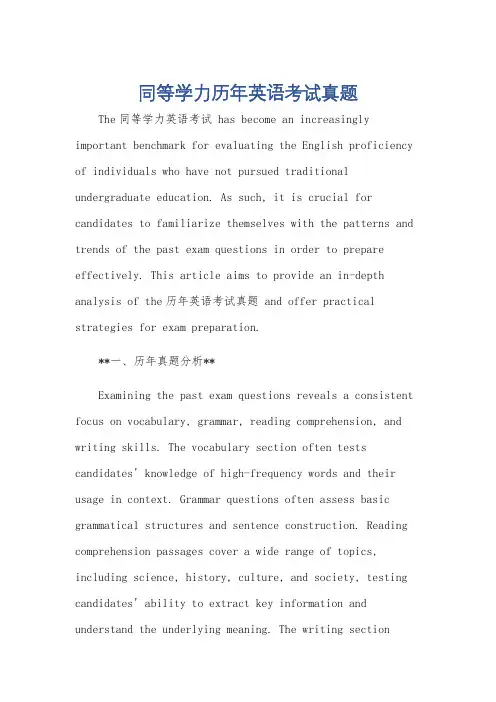
同等学力历年英语考试真题The同等学力英语考试 has become an increasingly important benchmark for evaluating the English proficiency of individuals who have not pursued traditional undergraduate education. As such, it is crucial for candidates to familiarize themselves with the patterns and trends of the past exam questions in order to prepare effectively. This article aims to provide an in-depth analysis of the历年英语考试真题 and offer practical strategies for exam preparation.**一、历年真题分析**Examining the past exam questions reveals a consistent focus on vocabulary, grammar, reading comprehension, and writing skills. The vocabulary section often tests candidates' knowledge of high-frequency words and their usage in context. Grammar questions often assess basic grammatical structures and sentence construction. Reading comprehension passages cover a wide range of topics, including science, history, culture, and society, testing candidates' ability to extract key information and understand the underlying meaning. The writing sectionoften requires candidates to write an essay or a letter, emphasizing their ability to express ideas clearly and coherently.**二、备考策略**In order to effectively prepare for the同等学力英语考试, candidates should adopt a multi-faceted approach. Firstly, they should focus on expanding their vocabulary by regularly studying and practicing with new words and their usages. This can be achieved through reading newspapers, magazines, and other materials that are relevant to the exam.Secondly, candidates should master basic grammatical rules and sentence structures. This can be done byreferring to grammar books, taking grammar classes, or practicing sentence construction exercises. Byfamiliarizing themselves with these rules, candidates will be better prepared to handle grammar questions in the exam. Thirdly, improving reading comprehension skills is crucial. Candidates should practice reading a wide range of materials, including newspapers, novels, and academic articles. This will help them develop a betterunderstanding of different topics and improve their ability to extract key information from passages.Lastly, candidates should work on their writing skills by practicing essay writing and letter writing. They can start by writing simple essays and gradually progress to more complex ones. They should also pay attention to the clarity and coherence of their writing, ensuring that their ideas are expressed clearly and logically.**三、结论**In conclusion, familiarizing oneself with the patterns and trends of the past exam questions and adoptingeffective备考策略are key to successfully preparing for the 同等学力英语考试. Candidates should focus on expandingtheir vocabulary, mastering basic grammatical rules, improving reading comprehension skills, and developingtheir writing abilities. By doing so, they will be well-prepared to achieve their desired results in the exam.**历年真题深度解析与备考策略**同等学力英语考试已成为评价未接受传统本科教育个人英语水平的重要标准。
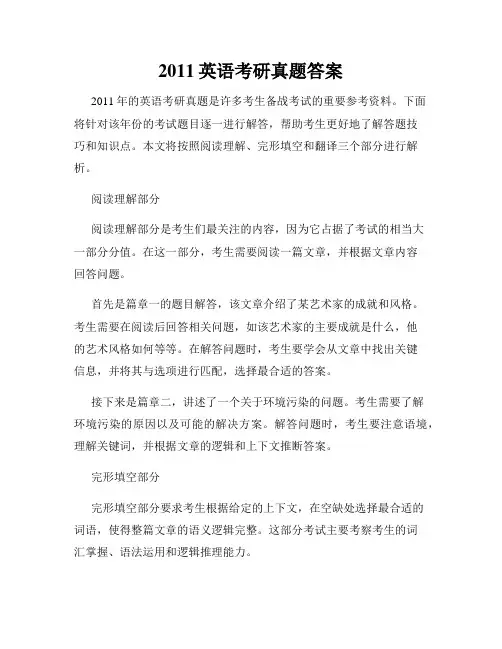
2011英语考研真题答案2011年的英语考研真题是许多考生备战考试的重要参考资料。
下面将针对该年份的考试题目逐一进行解答,帮助考生更好地了解答题技巧和知识点。
本文将按照阅读理解、完形填空和翻译三个部分进行解析。
阅读理解部分阅读理解部分是考生们最关注的内容,因为它占据了考试的相当大一部分分值。
在这一部分,考生需要阅读一篇文章,并根据文章内容回答问题。
首先是篇章一的题目解答,该文章介绍了某艺术家的成就和风格。
考生需要在阅读后回答相关问题,如该艺术家的主要成就是什么,他的艺术风格如何等等。
在解答问题时,考生要学会从文章中找出关键信息,并将其与选项进行匹配,选择最合适的答案。
接下来是篇章二,讲述了一个关于环境污染的问题。
考生需要了解环境污染的原因以及可能的解决方案。
解答问题时,考生要注意语境,理解关键词,并根据文章的逻辑和上下文推断答案。
完形填空部分完形填空部分要求考生根据给定的上下文,在空缺处选择最合适的词语,使得整篇文章的语义逻辑完整。
这部分考试主要考察考生的词汇掌握、语法运用和逻辑推理能力。
在这部分的解答中,考生应该首先通读全文,大致了解文章的主题和脉络。
然后,根据上下文理解词汇,选择最适合的词语填入空白处。
要注意上下文的逻辑关系,以及句子的时态一致性和语法规则。
翻译部分翻译部分要求考生根据所给的英文句子,将其翻译成中文。
这部分考试主要考察考生的语法掌握和翻译能力。
在这部分的解答中,考生应该首先理清句子的结构和语法规则,理解句子的意思。
然后,将其准确地翻译成中文,注意语序和用词的准确性。
在翻译时,可以适当运用一些翻译技巧和翻译常用结构,使翻译更加地准确和流畅。
总结根据2011年英语考研真题的解析,可以看出,在备考过程中,考生首先要加强词汇和语法的复习,提高自己的语言基础。
另外,注重阅读理解的练习和技巧的掌握也非常重要。
熟悉题目类型和解题思路,能够提高答题速度和准确度。
最后,在翻译部分,要理解句子的结构和含义,准确地进行翻译。
1 2011年同等学力英语考试历年真题及参考答案 Part One (90 minutes) Part 1 Dialogue communication (10 minutes, 10 points, 1 for each) Section A Dialogue completion
1. A: David said he bought a new BMW for $5,000! B: _____. Sounds pretty cheap to me! A: Well, that’s what he said. A. Are you sure? B. Come to think of it. C. Do you think so? D. Is he crazy? 2. A: We just came back from Phoenix. And we had the best vacation in years. B: ____. I’m glad to hear it. A. Oh, my goodness! B. How was it? C. Oh, there you go again. D. Good for you. 3. A: I just can’t stand this class anymore? B: ____. It’s required, and you have to sit in it in order to graduate. A. Well, why not just drop out of it? B. Why, you can say that again! C. Well, you might as well get used to it. D. Why, I couldn’t agree more! 4. A: I don’t know about you, but I thought that film was terrific. B: ____. The action was great, and so was the music. A. Just the same. B. I’m with you there. C. More or less. D. I sure do. 5. A: Dan gave me a free ride home, but I paid for the gas. B: You know what they say, ____. A. there’s no free lunch B. don’t bite off more than you can chew C. one good turn deserves another D. it’s who you know that counts
Section B Dialogue Comprehension 6. Woman: I’d rather not talk about it. Just don’t ask. Man: Come on. I think you need to let off some steam. 2
Question: What does the man advise the woman to do? A. To talk to him about the problem. B. To keep the secret. C. To reduce the workload. D. To have a good rest. 7. Woman: Julie’s dress looks funny. That style went out last year. Man: Oh, come on, as long as it looks good on her. Question: What does the man try to emphasize? A. Julie’s dress is not outdated. B. Julie’s dress does not suit her. C. Julie should follow the fashion. D. Julie looks fine in that dress. 8. Man: What kind of snacks do you prefer? Woman: Oh, I’ve got a sweet tooth, you know. Question: What does the woman probably like? A. Sandwich. B. Hot dogs. C. Ice cream. D. Potato chips. 9. Woman: I’m tired of driving all the way to work and back every day. If only cars could drive themselves! Man: Well, some car manufactures are working on them. I guess you’ll soon buy one if you can afford it. Question: What does the man imply? A. The woman will be able to buy an intelligent car. B. Cars that drive themselves may be very expensive. C. He is working with a car producer on intelligent cars. D. Driving to work is really a headache. 10. Man: Annie, how does it not even cross your mind that you might want a future with someone? Woman: It’s simple. I don’t mind being married to my career. Question: What’s Annie’s attitude towards her future? A. She will stay with someone unmarried. B. She will live a simple life. C. She will quit her job to get married. D. She will fully focus on her job.
Part II Vocabulary (20 minutes, 10 points, 0.5 for each) Section A 11. The news reports completely overlooked the more profound political implications of the events. A. neglected B. foresaw C. explored 3
D. assessed 12. Teachers and nurses who deal with children are obliged to report cases of suspected child abuse to authorities. A. reminded B. expected C. compelled D. requested 13. Your grade will be based in large part on the originality of your ideas. A. creativity B. popularity C. feasibility D. flexibility 14. We suspect there is a quire deliberate attempt to sabotage the elections and undermine the electoral commission. A. conscious B. desperate C. clumsy D. intentional 15. So strange were the circumstances of my story that I can scarcely believe myself to have been a party to them. A. just B. hardly C. almost D. definitely 16. Smoke particles and other air pollutants are often trapped in the atmosphere, thus forming dirty fog. A. constrained B. caught C. concealed D. concentrated 17. Employees in chemical factories are entitled to receive extra pay for doing hazardous work. A. poisonous B. difficult C. dangerous D. harmful 18. Curt Carlson, the wealthiest man in Minnesota, owned a hotel and travel company with sales reaching in the neighborhood of $9 billion. A. precisely B. merely C. substantially D. approximately 19. The tendency of the human body to reject foreign matter is the main obstacle to successful organ transplantation.